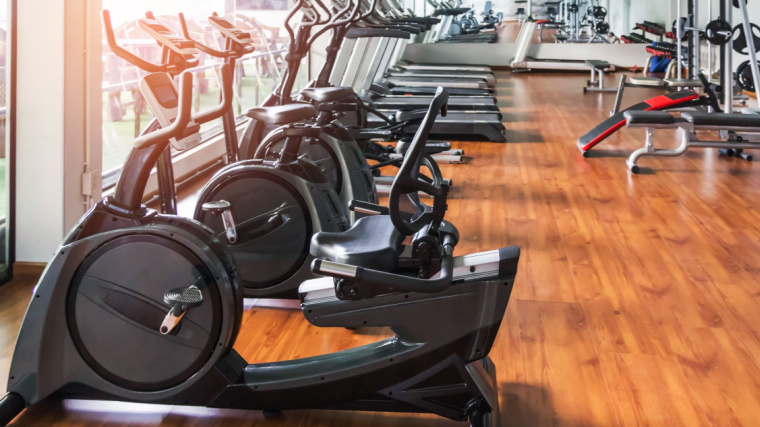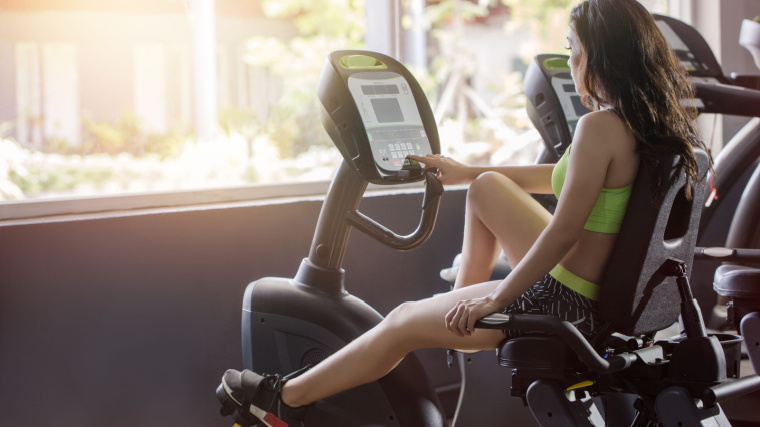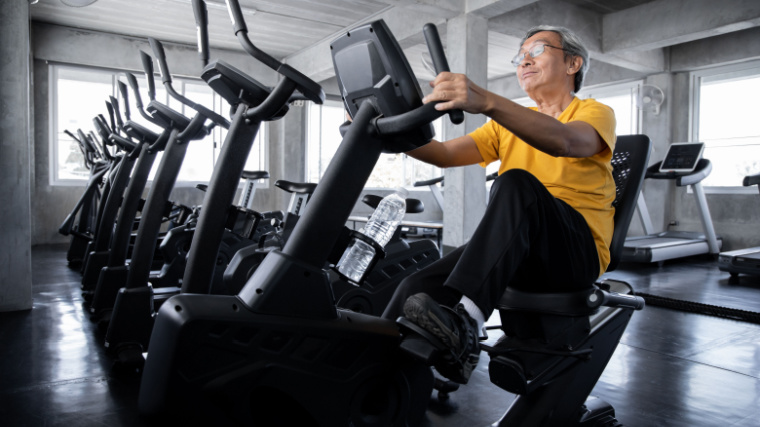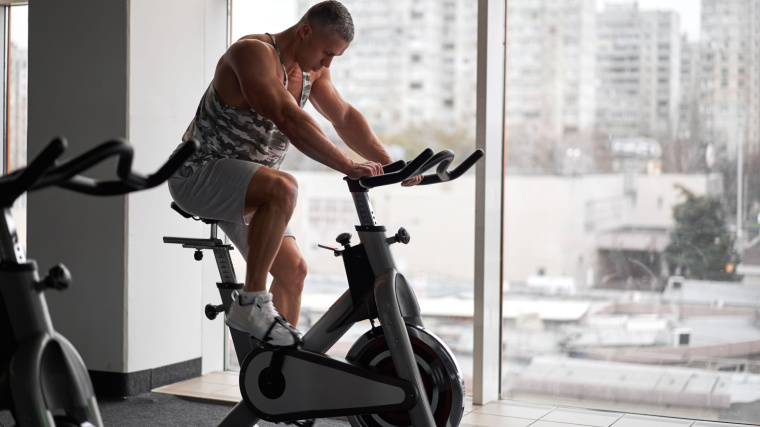Starting a new workout program is often exciting. You’ve got a new goal, and you’re motivated to reach it. After a while, the motivation may wear off, and it takes consistency to keep going. One way to stick to your plan after the excitement fades is to choose an activity you enjoy. When it comes to cardio, for many people, it’s cycling.
The weather doesn’t always let you hop on a regular bike, so stationary bikes can come in handy. You also may be recovering from an injury or having joint pain. Whatever reason you enter the world of indoor cycling, you’ll notice different types of exercise bikes. Two popular types are the recumbent and upright bikes. Both can give you a great cardio workout.

Here, we’ll tell you everything you need to know about both stationary bikes. We’ll dive into their differences, similarities, pros and cons, and how to use each. Maybe you’re looking to choose the best exercise bike for your home gym or wondering which is best for your fitness goals. Recumbent bike versus upright bike: let’s get into it.
- Key Differences
- Key Similarities
- What Is a Recumbent Bike?
- The Benefits of the Recumbent Bike
- The Cons of the Recumbent Bike
- How to Use the Recumbent Bike
- What Is an Upright Bike?
- The Benefits of the Upright Bike
- The Cons of the Upright Bike
- How to Use an Upright Bike
Key Differences
The recumbent bike and upright bike each provide a cycling cardio workout. Here are some high-level differences.
- Riding Position: The main difference is the seat position, which determines the riding position. On the recumbent bike, you sit in a reclined position with the seat horizontally in line with the flywheel and pedals. You’re in an upright position on the upright bike, with the seat vertically on top of the flywheel and pedals. You can also lean forward to hold onto the handlebars.
- Seat Size: The recumbent bike has a larger seat that is lower to the ground. It may be more comfortable and easier to access for people who use wheelchairs. The upright bike has a smaller bike seat more similar to that of a mobile bicycle.
- Back Support: The recumbent bike offers a backrest to provide back support, which may be beneficial for people with back pain or joint pain. On the upright bike, there’s no backrest, and you stay in an upright position by using your core.
- Muscle Engagement: Since the recumbent bike offers a reclined position with back support, there is less core engagement and minimal upper body work required. On the upright bike, you must engage your core to support your spine. If you sit up without leaning forward, you’ll also work your upper body muscles.
- Level of Intensity: You can work your lower body on the recumbent bike and increase the speed and resistance. The upright bike generally provides a more intense workout due to the body position and muscle engagement. It’s also more versatile and great for high-intensity interval training (HIIT).
Key Similarities
Here’s where the two stationary bikes overlap.
- Improves Cardiovascular Fitness: Doing cardio workouts on both bikes regularly will improve your cardiovascular fitness and health. They raise your heart rate, and you can keep it up through your workout. Over time, you’ll build endurance on either machine.
- Burns Calories: Both bikes will burn calories and can be part of a weight loss program. However, you may burn more calories faster on the upright bike due to its intensity.
- Low-Impact Cardio: The recumbent bike and the upright bike are both low-impact. By sitting down, you’re not supporting your weight. They put less stress on your joints than weight-bearing exercises.
- Works Lower Body Muscles: Both cycling bikes use your lower body to pedal. You’ll engage your glutes, hamstrings, quadriceps, calves, and anterior tibialis. You can also engage your core muscles on both, even if the recumbent bike is less intense.
- Scalable for Fitness Levels: The recumbent bike may be more friendly to beginners, but both bikes can work for people new to the gym. For higher fitness levels, the upright bike may be better. But if you’re an athlete in physical therapy, the recumbent bike can be a key asset in your recovery.
What Is a Recumbent Bike?
A recumbent exercise bike is an indoor, stationary bike for cardio exercise. You sit in a reclined, large seat with a backrest. The pedals are in front of your body. The seat is low to the ground, and there are handlebars on each side of the seat. There is often a screen where you can adjust your speed and resistance, track your workouts, or choose entertainment options.
The Benefits of the Recumbent Bike
Recumbent bikes are a popular type of cardio equipment in physical therapy offices and sports rehabilitation clinics due to their lower back support. They are also great for older adults or people with mobility issues. They provide a scalable cardio workout with comfort. Here are the top benefits.
Low-Impact Cardio Benefits
Cycling is a form of cardio or aerobic exercise. Aerobic exercise is any activity you perform rhythmically for a time that engages multiple muscle groups and raises your heart rate and respiration. Aerobic exercise improves your cardiovascular fitness. (1)
Regular cardio exercise is well-known to improve your cardiovascular (CV) health by preventing heart disease and other CV conditions. Research links cycling, particularly, with a lower risk of CV diseases and mortality. All types of cardio exercise can also improve your mental health by decreasing symptoms of anxiety and depression and boosting your mood and cognition. (2)(3)(4)

[Read More: 5 At-Home Workouts for Strength, Muscle Growth, Power, and More]
Both exercise bikes are low-impact cardio, so people who need a workout without supporting their body weight can get all the physical and mental health benefits of cardio. The recumbent bike has even less impact than the upright bike because of the back support and reclined position. The backrest protects your lower back so you can hit the pedals.
The recumbent bike is excellent for low-intensity steady-state (LISS) cardio. In LISS, you maintain a moderate heart rate and effort for a longer time than shorter, high-intensity bursts of activity. LISS can boost your cardio health and fitness, increase endurance, and build aerobic capacity.
Works Lower Body Muscles
A recumbent bike workout will work all of your lower body muscles. In the cycling movement pattern, your glutes and your quadriceps work together to flex your hip. During hip extension, your hamstrings and calves engage. (5)
A study used electromyography (EMG) to measure lower body muscle activity in people using a recumbent bike, an upright bike, a treadmill, and a type of elliptical. The study found that all four devices caused similar muscle activation in the abdominal muscles, hamstrings, and glutes. However, it states that they were below the “strengthening stimulus.” Still — they’re working. (5)
[Read More: The 17 Best Lower Body Exercises to Level-Up Your Leg Day]
Another study used an EMG to compare muscle activity in the recumbent bike to the upright bike. It measured activation of the rectus femoris (quadriceps), semitendinosus (hamstrings), tibialis anterior, and medial gastrocnemius (calves). (6)
The study found similar muscle engagement in all four muscles in both bikes. The hamstrings and tibialis anterior were slightly more active on the recumbent bike, and the quadriceps engagement was somewhat greater on the upright bike. (6)
Helpful For Joint Pain and Recovering From Injuries
The recumbent bicycle can be an excellent option for people with joint pain, specifically back pain. The wide, comfortable seat and backrest support your lower back so you can focus on working your glutes and legs to get your heart rate up.
Physical therapy clinics often have recumbent bikes for this reason. Athletes can still work on their cardiovascular fitness and keep their muscles active during injury recovery.
[Read More: What You Need to Know About Muscle Recovery]
Research suggests that the recumbent bike may be helpful for sports rehabilitation since you are still getting muscle activation in your lower body, even though it’s a less intense workout than the upright bike. (6)
Great for Older Adults
The recumbent bike is accessible for older adults who may use a wheelchair or have limited mobility. It’s easier to get into the seat because it’s lower to the ground than the upright bike.
A study on 100 older adults, ages 50 to 83, showed that outdoor cycling improved cognitive and executive functioning and boosted mental health and well-being. If an older adult can’t do outdoor cycling, the recumbent bike may yield similar results. (7)

[Read More: The 16 Best Pre-Workout Supplements]
The recumbent bike is not a weight-bearing exercise. For people who can’t do weight-bearing exercise, it’s great to have an option for a cardio workout. However, if you are cleared for it, research shows that weight-bearing exercise increases bone mineral density (BMD) in older adults with osteoporosis. (8)
A study on older adults with osteoporosis investigated adding weight-bearing versus non-weight-bearing exercise to their medical treatment. Although only weight-bearing exercise increased BMD, both types improved their overall quality of life. The study notes that physical therapy for osteoporosis should include both types. (8)
The Cons of the Recumbent Bike
Here are a few downsides of the recumbent bike.
Works Lower Body Only
Although studies show the recumbent bike can elicit some core muscle activation, it primarily works your lower body and doesn’t work your upper body at all. (5)
You can still maximize your workout by actively engaging your abdominal muscles and sitting tall in the seat. For athletes without any joint pain or injuries, you’ll engage more muscles on the upright bike.
Less Versatile Workouts
The recumbent bike is great for what it does — it provides a cardio workout for people who need (or want) to use the reclined position. If you’re looking for a more intense workout and versatility in your cycling, the upright bike may be a better fit.
Takes Up More Space
When choosing an exercise bike for your home gym, keep in mind that the recumbent bike is larger than the upright bike. If you’re working with a small space, measure the dimensions.
How to Use the Recumbent Bike
Ready to hop on?
- Adjust the seat position, sit down, and secure your feet on the pedals. Keep your back flat against the backrest.
- Set your resistance, speed, and desired length of time on the screen.
- Retract your head, engage your abs, and squeeze your glutes. Hold onto the handrails for support. Begin pedaling and actively engage your leg muscles throughout the workout.
- Start slowly to warm up, and cool down with a few minutes of slow pedaling after your ride.
What You Need: You’ll need a recumbent exercise bike, well-fitting shoes, and water to stay hydrated.
Setting Up: Adjust the seat position so you can recline comfortably. You should be able to have your feet on the pedals with your knees slightly bent.
What Is an Upright Bike?
An upright exercise bike is a stationary bike with a high seat that can simulate riding a regular bike. You sit upright with the seat above the pedals and the flywheel. You can lean forward to hold on to the handlebars or stay upright.
There is generally a screen where you can adjust your speed and resistance, choose pre-set workouts, and track your progress over time. There may also be entertainment options or spin class instructors to follow.

[Read More: The 8 Best Rowing Machines]
Upright stationary bikes, including spin bikes, are common in commercial gyms, home gyms, and spin classes. They sometimes have small weights for you to do upper body work during your ride.
The Benefits of the Upright Bike
The upright bike provides a generally more intense workout than the recumbent bike. It’s more versatile — you can do high-intensity or low-intensity cardio exercise. It’s similar to a regular bike, so cyclists can use it to prepare for a race or event. You’ll also get more muscular engagement due to the riding position.
Great for High-Intensity Interval Training
You’ll get all the cardiovascular health benefits of cardio by regularly cycling on an upright bike. It differs from the recumbent bike because you can also use it for high-intensity interval training (HIIT).
HIIT workouts involve short bursts of maximum effort (80 to 95 percent of your max heart rate) with short periods of active recovery (40 to 50 percent of your max heart rate). For example, on the upright bike, you can pedal as fast as possible for 15 seconds and then recover with moderate pedaling for one minute. Alternate and repeat for multiple rounds.
[Read More: The Best EMOM Workouts for Strength, Endurance, and Mass]
Doing cardio after lifting, like HIIT on the upright bike, can increase power and conditioning.
More Muscular Engagement
Sitting up tall on the upright bike requires you to work all your core muscles to stabilize your spine. Holding yourself in an upright position also works your upper body. In some cycling classes, people use light weights to do some arm exercises as well.
Engaging your upper and lower body muscles simultaneously during your cycling workout will raise your heart rate and provide an overall more intense workout. It’s not quite a full-body workout, but it’s closer.
Mimics Outdoor Cycling
The riding position of the upright bike is similar to that of a road bike. Cyclists preparing for a race or event can incorporate it into their training program.
[Read More: How to Become a Morning (Workout) Person]
When you’re trying to increase your speed and build endurance for a race, it can be helpful to train with indoor cycling. You won’t need to worry about the weather, traffic, terrain, or other cyclists. You can control your elements to build your capacity and increase your lactate threshold — the amount of time you can give all your effort before your muscles fatigue.
Versatile Workouts
The upright bike provides more versatile workouts than the recumbent bike. You can play with multiple variables to try different workouts based on your fitness goals and preferences.
- You can lean over and hold the handlebars for a longer LISS cardio workout.
- Alternate sprints with recovery periods for a HIIT cycling workout.
- Stay as upright as you can to strengthen your core muscles.
- Stand up while you ride for even more intensity.
- Add light weights to work your upper body muscles.
- Play with high resistance and a slower speed for more muscle activation.
- Keep the resistance lower, but go faster to build more endurance.
The Cons of the Upright Bike
The upright bike is great for its versatility and intensity, but here are a few drawbacks.
No Back Support
People with lower back issues may find the upright bike difficult because it does not have a backrest. It’s important to consult a medical professional or physical therapist to address injuries and joint issues.

However, once cleared to exercise, strengthening your core in resistance training can help. Learning to engage your core and cycle without a backrest may help you get stronger.
Seat May Be Uncomfortable
Some riders find the seat uncomfortable, and it takes time to adjust. Some find it helpful to wear padding, but it’s important to ride with the proper form and body position.
Tougher for Beginners
The upright bike can be challenging for beginners. Leaning over may seem easier, but it can also stress your lower back. Beginners in the gym should learn to engage their muscles and build their strength in resistance training. The new skills will help you out on the upright bike as well.
How to Use an Upright Bike
You’ve chosen the upright bike. Let’s get ready to ride.
- Sit up tall in your seat with your feet secured on the pedals. Choose your resistance level, speed, or pre-set workout on the screen. Hold on to the handlebars.
- Keep your spine tall, back straight, and abs engaged if you stay fully upright. Engage your abdominal muscles even if you are leaning forward.
- Begin pedaling as you engage your glutes and lower body muscles. Actively push and pull the pedals. Breathe throughout the workout.
- Start with a slow pedal to warm up, and finish with slow pedaling to cool down.
What You Need: There are many brands and types of upright bikes to choose from. Check to see if they require specific cycling shoes before hopping on. Otherwise, all you’ll need is your bike, your sneakers, and water for your ride.
Setting Up: Adjust your seat height to sit tall with your knees slightly bent, and secure your feet on the pedals.
Pedaling Up
The recumbent bike and the upright bike are both great options to improve your cardiovascular fitness and health. The recumbent bike is supportive and more comfortable, making it a better option for older adults, people with joint pain, and athletes in physical therapy. The upright bike is more versatile and intense, making it better for HIIT, body conditioning for strength athletes, and cyclists training for a race.
Due to the riding position, the upright bike requires more muscular engagement from your core and upper body. However, some studies show both can activate and engage your lower body muscles. Both can be great for cardio and endurance. It just depends on your fitness level and mobility status. Choose which is best for you, and enjoy the ride.
References
- Patel H, Alkhawam H, Madanieh R, Shah N, Kosmas CE, Vittorio TJ. Aerobic vs anaerobic exercise training effects on the cardiovascular system. World J Cardiol. 2017 Feb 26;9(2):134-138.
- Nystoriak MA, Bhatnagar A. Cardiovascular Effects and Benefits of Exercise. Front Cardiovasc Med. 2018 Sep 28;5:135.
- Nordengen S, Andersen LB, Solbraa AK, Riiser A. Cycling is associated with a lower incidence of cardiovascular diseases and death: Part 1 – systematic review of cohort studies with meta-analysis. Br J Sports Med. 2019 Jul;53(14):870-878.
- Sharma A, Madaan V, Petty FD. Exercise for mental health. Prim Care Companion J Clin Psychiatry. 2006;8(2):106.
- Bouillon L, Baker R, Gibson C, Kearney A, Busemeyer T. COMPARISON OF TRUNK AND LOWER EXTREMITY MUSCLE ACTIVITY AMONG FOUR STATIONARY EQUIPMENT DEVICES: UPRIGHT BIKE, RECUMBENT BIKE, TREADMILL, AND ELLIPTIGO®. Int J Sports Phys Ther. 2016 Apr;11(2):190-200.
- Lopes AD, Alouche SR, Hakansson N, Cohen M. Electromyography during pedaling on upright and recumbent ergometer. Int J Sports Phys Ther. 2014 Feb;9(1):76-81.
- Leyland LA, Spencer B, Beale N, Jones T, van Reekum CM. The effect of cycling on cognitive function and well-being in older adults. PLoS One. 2019 Feb 20;14(2):e0211779.
- Shanb AA, Youssef EF. The impact of adding weight-bearing exercise versus nonweight bearing programs to the medical treatment of elderly patients with osteoporosis. J Family Community Med. 2014 Sep;21(3):176-81.
Featured Image: Soonthorn Wongsaita / Shutterstock
The post Recumbent Bikes Vs. Upright Bikes — Which Is Best for Your Goals? appeared first on BarBend.
